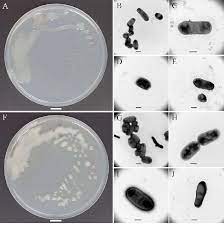Mesorhizobium onobrychidis
Mesorhizobium onobrychidis

Classification
Domain: Bacteria
Phylum: Pseudomonadota
Class: Alphapoteobacteria
Order: Hyphomicrobiales
Family: Phyllobacteriaceae
Species
|
NCBI: [1] |
Genus species
Description and Significance
Mesorhizobium onobrychidis is part of the genus, Mesorhizobium, which are gram negative bacteria that live in tropical, temperate, sub-tropical, and arctic soils. M. onobrychidis induces plant legume nodules and assists the plant with nitrogen and carbon dioxide fixation. Though it is very similar to other species in its genus, it has one of the largest strains and highest number of genes that code for these specific functions: biofertilization, phytohormone, plant signal production, stress resistance, competitive exclusion, and plant immune response stimulation. This species directly affects plant growth performance and even has a set of plant growth promotion traits.
Genome Structure
This species contains a unique genomic island and has a high density of symbiotic genetic traits. The complete genome size is 7.55 Mb and the circular chromosome is 7.32 Mb and contains one circular plasmid of 227 kb. The guanine-cytosine composition contains a large genomic island of 61.9%. It contains 414 genes and multiple gene clusters that are similar to other Mesorhizobium strains. There are a total of 2,683 core, 1,151 accessory, 2,444 cloud, and 1,068 unique genes. Mesorhizobium onobrychidis has approximately 2.5 times more genes than any other Mesorhizobium strains on average.
Cell Structure, Metabolism and Life Cycle
This species has the ability to perform nodulation and biosynthesize vitamin B3 and pilus-fimbriae. It utilizes plant metabolites like amino acids and also degrades salicylic acid. It adapts to the plant’s metabolism that it is attached to, meaning it does not have its own set of carbohydrates, amino acids, and nucleotides.
It is immobile and lacks the genes for chemotaxis. It has no flagella.
Ecology and Pathogenesis
This microbe lives on the root nodules of plants. It assists in carbon and nitrogen fixation. It has a mutualistic relationship with the plants it lives on. It provides the plant with nitrogen from the atmosphere and in exchange the pant provides the microbe with the photosynthesis product carbon
Plants that have been found with his microbe have showed a much faster progression in growth and are seen to be healthier.
Achieves colonization inside the plant via biofilms
References
Ashrafi, S., Kuzmanović, N., Patz, S., Lohwasser, U., Bunk, B., Spröer, C., Lorenz, M., Elhady, A., Frühling, A., Neumann-Schaal, M., Verbarg, S., Becker, M., & Thünen, T. (2022). Two New Rhizobiales Species Isolated from Root Nodules of Common Sainfoin (Onobrychis viciifolia) Show Different Plant Colonization Strategies. Microbiology spectrum, 10(5), e0109922. https://doi.org/10.1128/spectrum.01099-22
Loranjo M, Alexandre A, Oliveira S. (2014). Legume growth-promoting rhizobia: An overview on the Mesorhizobium genus. Microbiological Research. 169(1): 2-17. https://doi.org/10.1016/j.micres.2013.09.012
LPSN. (n.d.). Species Mesorhizobium Onobrychidis. Species: Mesorhizobium onobrychidis. https://lpsn.dsmz.de/species/mesorhizobium-onobrychidis
Author
Page authored by Amaya Pitts, student of Prof. Bradley Tolar at UNC Wilmington.